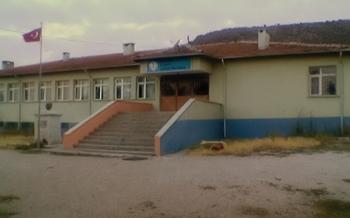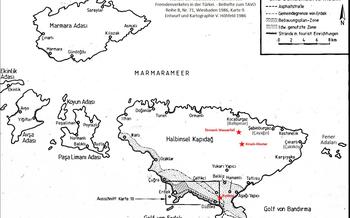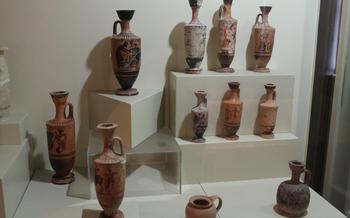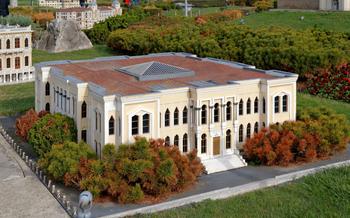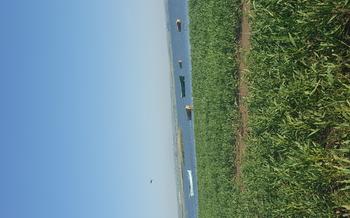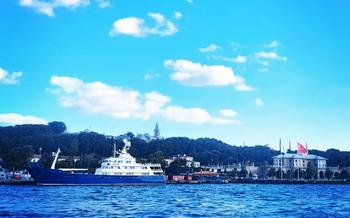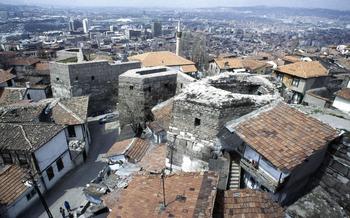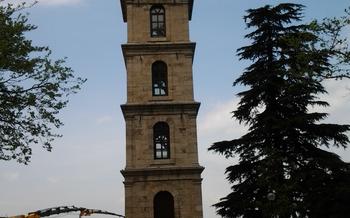
Balya Maden Evi (Mining House)
- Balya Maden Evi (Mining House)
- Transportation to Balya Maden Evi
- Visiting the Balya Maden Evi
- Mining History in Balya
- Mining Tools and Equipment
- The Life of a Miner
- Local Crafts and Traditions
- Unique Features of Balya Maden Evi
- Historical Significance of the Mining Industry
- Experiences for Visitors
- Nearby Attractions
- Accommodations and Dining
- Shopping for Souvenirs
- Planning Your Visit
- Insider Tips
Balya Maden Evi (Mining House)
Located in the picturesque village of Balya, in the Balıkesir province of Turkey, the Balya Maden Evi (Mining House) stands as a testament to the region's rich mining history. Established in 1998, this unique museum offers visitors a fascinating glimpse into the world of mining and its profound impact on the local community.
The Balya Maden Evi is housed in a beautifully restored 19th-century building, which once served as the administrative center of the Balya mining operations. Inside, visitors will find a wealth of exhibits and displays that bring the history of mining in Balya to life. The museum's collection includes mining tools, equipment, machinery, photographs, and documents, providing a comprehensive overview of the industry's development and significance.
The village of Balya, nestled amidst rolling hills and lush forests, has been intricately linked to mining for centuries. The Balya mining industry, which dates back to ancient times, played a pivotal role in shaping the region's economy and culture. The museum serves as a valuable resource for understanding the legacy of mining in Balya and its enduring impact on the local community.
Transportation to Balya Maden Evi
The Balya Maden Evi is situated in the picturesque village of Balya, in the northwestern province of Balıkesir, Turkey. To reach this historic site, travelers can embark on a scenic journey by road. The distance from nearby cities varies, with Balıkesir city being approximately 100 kilometers away. For those relying on public transportation, there are regular bus services connecting Balıkesir and Balya, offering a convenient and affordable option. Alternatively, visitors can opt for the flexibility of renting a car, allowing them to explore the region at their own pace. Once in Balya, the Balya Maden Evi is easily accessible on foot or by taxi, ensuring a hassle-free arrival for all visitors.
Visiting the Balya Maden Evi
The Mining House comprises a museum building and outdoor mining exhibits. The museum showcases a rich collection of artifacts, including mining tools, machinery, and historical documents that narrate the captivating story of Balya's mining past. Interactive exhibits bring the history to life, providing a hands-on and engaging experience for visitors of all ages.
Visitors can explore the history of the local mining industry through engaging exhibits, including interactive displays, multimedia presentations, and virtual reality experiences. The museum also offers guided tours led by knowledgeable experts who provide insights into the history, culture, and legacy of the region's mining heritage.
Guided tours are available in multiple languages and can be booked in advance or upon arrival. Visitors can choose from a variety of tour options, tailored to different interests and age groups. The tours offer a deeper understanding of the mining processes, the lives of miners, and the impact of mining on the local community.
Mining History in Balya
The village of Balya has a rich mining history that dates back to ancient times. The earliest evidence of mining in the area comes from the Roman period, when the Romans mined for gold and silver. Mining activities continued in Balya throughout the Byzantine and Ottoman periods, and the village became a major center for the production of silver and lead.
In the 19th century, the mining industry in Balya experienced a significant boom. This was due in part to the discovery of new mineral deposits, as well as the introduction of new mining technologies. During this period, Balya became one of the most important mining centers in the Ottoman Empire.
The mining industry in Balya declined in the early 20th century due to a number of factors, including the depletion of mineral deposits and the rise of new mining centers in other parts of the country. However, mining continued in Balya on a smaller scale until the 1960s.
The legacy of mining in Balya is still visible today. The village is home to a number of abandoned mines and mining structures, as well as the Balya Maden Evi (Mining House), which is a museum dedicated to the history of mining in the area.
Mining Tools and Equipment
The Balya Mining House showcases a fascinating array of mining tools and equipment that provide insight into the techniques and technologies used throughout the history of mining in the region. From simple hand tools to sophisticated machinery, the museum's collection offers a comprehensive overview of the evolution of mining technology.
Visitors can see various types of picks, shovels, and drills used by miners to extract ore from the earth. These tools were often made from locally sourced materials, such as wood and iron, and were designed to be both durable and efficient. The museum also displays examples of more specialized tools, such as hammers, chisels, and wedges, which were used for specific tasks such as breaking up rocks or extracting minerals.
In addition to hand tools, the Balya Mining House exhibits a range of machinery that played a crucial role in the development of the mining industry. These include steam engines, which provided the power to operate pumps and other equipment, and ore carts, which were used to transport ore from the mines to the surface. The museum's collection also includes examples of early mining equipment, such as waterwheels and windmills, which were used to power pumps and other machinery before the advent of steam power.
Visitors to the Balya Mining House can gain a deeper understanding of the life of a miner by examining the tools and equipment they used. These artifacts provide a tangible connection to the past and help to bring the history of mining in Balya to life.
The Life of a Miner
The life of a miner in Balya was arduous and challenging. Miners typically worked long hours in difficult and dangerous conditions. They faced the constant risk of accidents, including cave-ins, explosions, and rockfalls. The work was physically demanding, as miners had to extract ore from deep underground, often using hand tools.
Miners typically lived in small, cramped houses near the mines. They often worked seven days a week, with little time for rest or relaxation. The working conditions were often harsh, with poor ventilation and inadequate safety measures. Miners were exposed to dust, fumes, and other hazardous substances, which could lead to health problems such as respiratory illnesses and silicosis.
Despite the challenges, mining provided a livelihood for many people in Balya. Miners were an important part of the local community, and their work contributed to the economic development of the region. The mining industry also played a role in shaping the local culture and traditions.
Local Crafts and Traditions
The mining industry in Balya has left a lasting impact on the local culture and traditions. Artisanal crafts related to mining, such as metalworking and jewelry-making, have flourished in the region. Visitors to Balya Maden Evi can witness these traditional crafts firsthand and even participate in workshops to learn the techniques themselves.
Beyond mining-related crafts, Balya is also known for its traditional customs and cultural events. The village hosts regular festivals and celebrations that showcase the unique heritage of the region. Visitors can immerse themselves in the vibrant local culture by attending these events, sampling the delicious local cuisine, and interacting with the friendly residents.
Preserving the local heritage is a priority in Balya. The Balya Maden Evi plays a crucial role in this endeavor by showcasing traditional tools, artifacts, and machinery related to mining. Through exhibitions, demonstrations, and educational programs, the museum helps visitors understand the significance of the mining industry and its impact on the local community.
Unique Features of Balya Maden Evi
The Balya Maden Evi stands out as a unique and captivating museum due to several remarkable features. Its architectural significance is evident in the well-preserved building, a testament to the region's mining history. The museum boasts special collections and exhibits that showcase rare artifacts, documents, and machinery related to mining. Interactive exhibits and displays engage visitors, allowing them to experience the mining process firsthand. Additionally, educational programs and workshops are offered, providing opportunities for visitors to delve deeper into the history and significance of mining in Balya.
Historical Significance of the Mining Industry
The mining industry in Balya played a pivotal role in the town's development and economic prosperity. The mines provided employment opportunities, generated revenue, and contributed significantly to the local economy. Mining also played a crucial role in the development of Balya's infrastructure, leading to the construction of roads, railways, and other essential facilities.
Moreover, the mining industry had a profound impact on the social and cultural fabric of Balya. Miners and their families formed a distinct community with unique traditions, customs, and values. The mining industry also shaped the town's physical landscape, leaving behind numerous mining structures, machinery, and artifacts that serve as a testament to its rich mining heritage.
The history of mining in Balya is an integral part of Turkey's industrial development. The country has a long and storied mining history, and Balya's mining industry played a significant role in shaping that history. The town's mines produced valuable minerals and metals that were used in various industries and contributed to Turkey's economic growth.
Preserving and showcasing the industrial heritage of Balya is essential for understanding the town's history and its role in Turkey's development. The Balya Maden Evi plays a crucial role in this preservation effort by providing a comprehensive overview of the town's mining industry, its historical significance, and its impact on the local community.
Experiences for Visitors
Balya Maden Evi offers a wide range of experiences for visitors of all ages and interests.
Visitors can explore the museum's exhibits at their own pace or join a guided tour to gain deeper insights into the history of mining in Balya. The knowledgeable guides provide fascinating explanations about the various mining techniques, tools, and equipment used over the centuries.
For a more immersive experience, visitors can participate in educational programs and workshops that allow them to try their hand at traditional mining activities. These hands-on experiences provide a unique opportunity to learn about the challenges faced by miners and the importance of their work.
The museum also hosts historical reenactments and events throughout the year. These events bring the past to life and allow visitors to experience the vibrant mining culture of Balya firsthand.
Nearby Attractions
Beyond the Balya Maden Evi, the region offers a wealth of additional attractions to enrich your visit. Delve into the captivating history of the region at the Balya Museum, where you can trace the town's evolution from ancient times to the present day. If you're an architecture enthusiast, don't miss the stunning Balya Mosque, a remarkable example of Ottoman architecture.
Immerse yourself in the natural beauty of the surrounding area, with its picturesque landscapes and hidden gems. Take a leisurely stroll along the scenic Balya River, enjoying the tranquility and serenity of the natural surroundings. For a breathtaking panoramic view, embark on a hike to the nearby Mount Madra, the highest peak in the region.
Indulge in the local culture and traditions by visiting the vibrant Balya Bazaar, where you can haggle for unique souvenirs and handicrafts. Savor the region's culinary delights at local restaurants, sampling traditional Turkish cuisine and savoring the flavors of Balya's specialty dishes.
Don't miss the opportunity to explore the surrounding towns and villages, each with its own distinct charm and character. Discover the hidden gems and lesser-known attractions that lie off the beaten path, such as the ancient ruins of the nearby town of Gönen or the picturesque village of Ayvalık, with its charming cobblestone streets and traditional architecture.
Accommodations and Dining
If you plan to delve deeper into the history and culture of Balya, you may consider extending your stay in the village. Balya offers a range of accommodation options to suit different budgets and preferences.
-
Hotels and Guest Houses: Several charming hotels and guesthouses in Balya provide comfortable accommodations with modern amenities. These establishments often feature traditional Turkish architecture and offer stunning views of the surrounding landscape.
-
Local Restaurants and Cafés: Balya has a small but vibrant culinary scene, with several local restaurants and cafés serving delicious Turkish cuisine. From traditional home-cooked meals to fresh seafood dishes, you'll find a variety of dining options to satisfy your taste buds.
-
Traditional Turkish Cuisine: When in Balya, don't miss the opportunity to sample traditional Turkish cuisine. Indulge in flavorful kebabs, savory börek pastries, and the famous Turkish delight, a sweet treat made with rose water and pistachio nuts.
-
Culinary Specialties of the Region: Balya is known for its unique culinary specialties, including fresh seafood dishes and locally produced olive oil. Be sure to try the grilled octopus, a local delicacy, and sample the region's olive oil, renowned for its rich flavor and health benefits.
Shopping for Souvenirs
Local Crafts and Handmade Items: Stroll through the local markets and bazaars to discover a treasure trove of handmade crafts and souvenirs. From intricate pottery and woven textiles to hand-carved wooden objects, you'll find a variety of unique items that showcase the skills and artistry of the local artisans.
Mining-Themed Souvenirs: As a nod to the region's mining heritage, be sure to pick up some mining-themed souvenirs. These could include miniature replicas of mining equipment, decorative items adorned with mining motifs, or even pieces of jewelry crafted from locally sourced minerals.
Turkish Delights and Sweets: Indulge in the sweet temptations of Turkish delights and other traditional confectioneries. These colorful treats, made from a combination of sugar, nuts, and spices, are a delightful way to savor the flavors of Turkey.
Carpets and Textiles: Balya is known for its vibrant carpets and textiles, which are woven using traditional techniques and natural dyes. Whether you're looking for a unique rug to adorn your home or a lightweight scarf to keep you warm, you'll find a wide selection of beautiful textiles to choose from.
Planning Your Visit
Best time to visit Balya Maden Evi
The best time to visit Balya Maden Evi is during the spring or fall, when the weather is mild and pleasant. Summer months can be hot and crowded, while winters can be cold and snowy.
Suggested duration of the visit
Plan to spend at least two hours exploring the Balya Maden Evi. This will allow you enough time to see the museum exhibits, take a guided tour, and experience the outdoor mining exhibits.
Tips for making the most of your visit
To make the most of your visit to the Balya Maden Evi, here are a few tips:
- Book a guided tour in advance to learn more about the history of mining in Balya and the significance of the museum.
- Wear comfortable shoes, as you will be doing a lot of walking both indoors and outdoors.
- Bring a camera to capture the unique exhibits and the beautiful surroundings of the museum.
- Take advantage of the educational programs and workshops offered by the museum, especially if you are traveling with children.
- Allow enough time to explore the nearby attractions, such as the Balya Museum, the Balya Castle, and the Balya Bazaar.
Accessibility for visitors with disabilities
The Balya Maden Evi is wheelchair accessible, and there are ramps and elevators to help visitors with disabilities navigate the museum. Guided tours can be arranged in sign language upon request.
Insider Tips
When visiting the Balya Maden Evi, make sure to explore the surrounding area to discover hidden gems and lesser-known attractions. Take a stroll through the village of Balya to soak up the local atmosphere and admire the traditional architecture. Visit the nearby Balya Castle, a well-preserved Byzantine fortress that offers stunning views of the region.
For a unique experience, participate in a traditional Turkish coffee ceremony at one of the local cafes. This is a great way to learn about Turkish culture and customs while enjoying a delicious cup of coffee. Be sure to sample the local cuisine, which is known for its fresh seafood and traditional Turkish dishes.
If you are interested in learning more about the mining history of the region, visit the Balya Mining Museum, which houses a collection of artifacts and exhibits related to the mining industry. For a hands-on experience, try panning for gold at the nearby Balya Gold Mine, where you can learn about the traditional methods of gold mining.
To make the most of your visit, take advantage of the guided tours offered by the Balya Maden Evi. These tours provide insights into the history and significance of the mining industry in Balya, making your visit even more informative and enjoyable.
